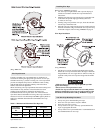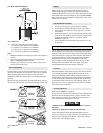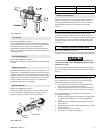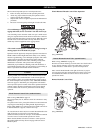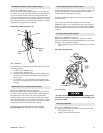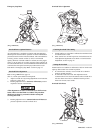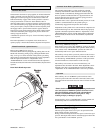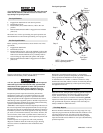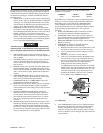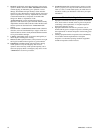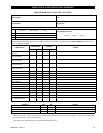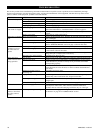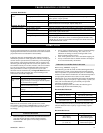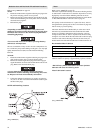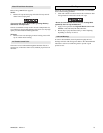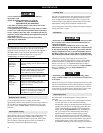
MHD56087 - Edition 4 17
REVIEW COPY 6
-
21
-
02
Frequent Inspection
On equipment in continuous service, frequent inspection should
be made by operators at the beginning of each shift. In addition,
visual inspections should be conducted during regular operation
for indications of damage or evidence of malfunction (such as
abnormal noises).
1. WINCH. Prior to operation, visually inspect winch housings,
controls, brakes, side rails, uprights and drum for indications
of damage. Any discrepancies noted must be reviewed and
inspected further by authorized personnel instructed in the
operation, safety and maintenance of this winch.
2. WIRE ROPE. Visually inspect all wire rope which can be
expected to be in use during the day’s operations. Inspect for
wear and damage indicated by distortion of wire rope such as
kinking, “birdcaging,” core protrusion, main strand
displacement, corrosion, broken or cut strands. If damage is
evident, do not operate winch until discrepancies have been
reviewed and inspected further by personnel knowledgeable
on wire rope safety and maintenance procedures.
NOTICE
• The full extent of wire rope wear cannot be determined by
visual inspection. At any indication of wear inspect the wire
rope in accordance with instructions in “Periodic Inspection.”
3. AIR SYSTEM. Visually inspect all connections, fittings,
hoses and components for indication of air leaks. Repair any
leaks or damage.
4. CONTROLS. During operation of winch, verify response to
control is quick and smooth. If winch responds slowly or
controls stick, do not operate winch until all problems have
been corrected.
5. BRAKES. During winch operation test brakes. Brakes must
hold load without slipping. Automatic brakes must release
when winch motor throttle is operated. If brakes do not hold
load, or do not release properly, brakes must be adjusted or
repaired.
6. WIRE ROPE REEVING. Check reeving and ensure wire
rope is properly secured to the drum. Do not operate winch
unless wire rope feeds onto the drum smoothly.
7. LUBRICATION. Refer to “LUBRICATION” section for
recommended procedures and lubricants.
8. PENDANT (optional feature). Ensure operation of pendant
levers is smooth and that winch is responsive to pendant
control. Pendant levers must spring return to neutral position
when released.
9. MANUAL THROTTLE LEVER. Ensure operation of
manual throttle lever is smooth and winch is responsive to
lever movement. Lever must return to neutral and lock in
place when released. If winch responds slowly or controls
stick, do not operate winch until all problems have been
corrected.
10. MOTOR. During operation check motor housing for excess
heat build up. Housing should not be hot to touch. Listen for
grinding or knocking noises. Ensure lubricated air supply
provides 6 to 9 drops per minute of ISO VG 32 (SAE 10W)
oil when winch is operated at rated capacity. Operate winch
slowly in both directions to verify operation.
Periodic Inspection
Periodic inspection intervals for winch use under various
conditions is listed below:
NORMAL HEAVY SEVERE
yearly semiannually quarterly
Disassembly may be required as a result of frequent inspection
findings or in order to properly inspect individual components.
Disassembly steps are described in the “MAINTENANCE”
section. Maintain written records of periodic inspections to
provide an accumulative basis for continuing evaluation. Inspect
all items listed in ‘Frequent Inspection.’ Also inspect the
following:
1. RAILS and UPRIGHTS. Check for deformed, cracked or
corroded main components. Replace damaged parts.
2. FASTENERS. Check retainer rings, split pins, capscrews,
nuts, and other fasteners on winch, including mounting bolts.
Replace if missing or damaged and tighten if loose.
3. DRUM and SHEAVES. Check for cracks, wear or damage.
Replace if necessary.
4. WIRE ROPE. In addition to ‘Frequent Inspection’
requirements, also inspect for the following:
a. Buildup of dirt and corrosion. Clean with steam or a stiff
wire brush to remove dirt and corrosion if necessary.
b. Loose or damaged end connection. Replace if loose or
damaged.
c. Check wire rope anchor is secure in drum.
d. Verify wire rope diameter. Measure the diameter of the
wire rope from crown-to-crown throughout the life of
the wire rope. Recording of the actual diameter should
only be done with the wire rope under equivalent
loading and in the same operating section as
accomplished during previous inspections. If the actual
diameter of the wire rope has decreased more than 1/64
inch (0.4 mm) a thorough examination of the wire rope
should be conducted by an experienced inspector to
determine the suitability of the wire rope o remain in
service. Refer to Dwg. MHP0056 on page 17.
(Dwg. MHP0056)
5. ALL COMPONENTS. Inspect for wear, damage, distortion,
deformation and cleanliness. If external evidence indicates
damage, disassemble as required to conduct a detailed
inspection. Inspect gears, shafts, bearings, sheaves, springs
and covers. Replace worn or damaged parts. Clean, lubricate
and reassemble.



